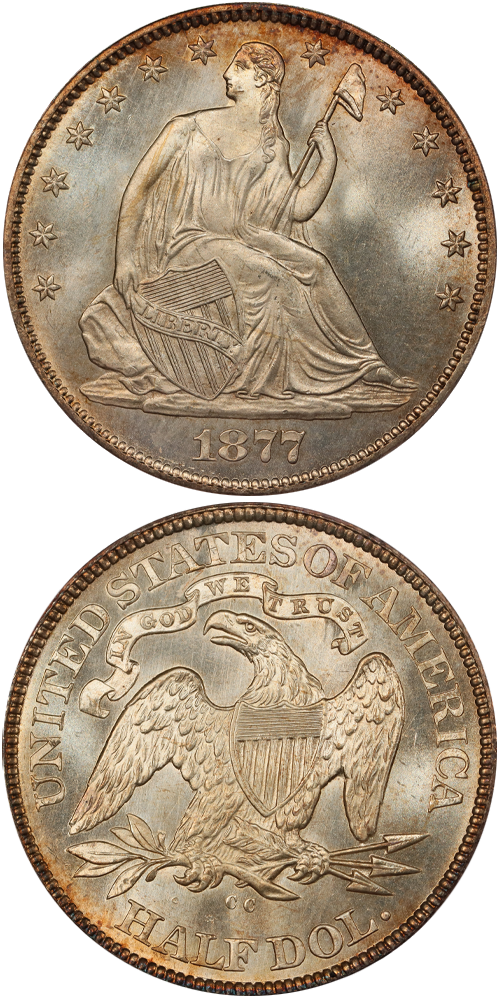1877-CC Liberty Seated Half Dollar
Jeff Ambio: WB-11 is one of the two Repunched Date varieties of this issue, distinguishable from WB-12 by the presence of a small die lump under Liberty's chin. Both varieties share the same reverse die, from the Type II hub with a Medium CC mintmark. In the early die state represented by the present coin there is no evidence of die clashing on the obverse between the base of the rock and the date or on the reverse between the top of the scroll and the letters ES in STATES.
Rusty Goe: The University of Nevada at Reno houses nearly complete sets of newspapers dating back to the 1860s that chronicle the Silver State's history. We turn to one of those newspapers in UNR's archives for a glimpse of Virginia City. "Here is a city of about 25,000 inhabitants," wrote the New York Tribune correspondent on August 27, 1875. "Here are restaurants as fine as any in the world," and "drinking saloons more gorgeous ... than any in San Francisco, Philadelphia, or New York...I have never seen finer shops than are here, and the number of diamonds displayed in the windows quite overwhelms one's senses."
Local newspapers in Carson City kept everyone in that hamlet abreast of the latest developments on the Comstock and on all affairs at the neighborhood mint. Briefings in January and February 1877 informed readers that coinage production had slumped in the first month of the year as compared to the December 1876 output. The Daily Nevada State Journal of February 4, 1877, provided two reasons for the drastic reduction in gold coin production from December to January: mechanical problems had prevented the striking of double eagles, and a sufficient supply of half eagles and eagles had eliminated the need for more.
The coiners maintained a consistent though at times intermittent tempo through the rest of the year. The annual total for half dollars was 1,420,000, about 72 percent of the quantity turned out the year before. Despite the decrease in mintage, the survival population for 1877-CC half dollars is greater than that of its counterpart from 1876. In grades MS-66 and above, however, the two dates appear equal in extant pieces.
Q. David Bowers: With a production of 1,420,000 pieces the 1877-CC is the last of the easily available Carson City half dollars. Although the production is slightly below that of 1876-CC, in studying various market appearances Rusty Goe has concluded that 5,000 to 7,500 exist in all grades, mostly at levels from VG to VF. He estimates that only 1,000 to 1,500 qualify as EF or AU, and 450 to 750 as Mint State, setting a record in this regard. In the last category the pieces can be reckoned as scarce, but certainly available.
For this year Wiley and Bugert have found the reed count on all to be 143, a significant change from the long-time standard of 154 used from 1870 through 1875. Fifteen die combinations were found, from 12 obverse dies and 13 reverse dies. Small and medium mintmark varieties exist.
The example to the left was sold by Stack's Bowers Galleries in the 2007 Orlando Auction, where it realized $43,700.






